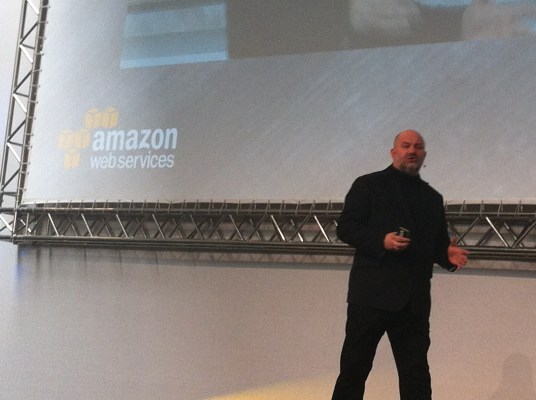Amazon’s business model, CTO Werner Vogels reminded us today, is based on “low margins, high volume”, and today the company announced a development on how it’s applying that principle to its enterprise services. From today, AWS is expanding to Europe its Redshift data warehousing service and its EC2 High Storage service. Amazon first announced the intention to take Redshift global in February; it’s actually turning on Europe today.
The news of the international expansion was made this morning during the Amazon Web Services Summit in London, part of a wider roadshow for AWS. Redshift, Amazon’s petabyte-scale solution to better manage huge backlogs of data, was first announced in November 2012. It is very competitive on price: traditional data warehousing solutions can cost between $19,000 and $25,000 per terabyte while Redshift charges $1,000 per terabyte per year.
Big data, Vogels said in a speech today, will be the crux of competitive advantage in the future, but also, it can be the biggest stumbling block. “The database will be the bottleneck,” he said.
Vogels also took the audience through what he sees as the cloud services to watch in the future — a primer, of sorts, for what we may expect to see from AWS in terms of its product roadmap.
Internet of things: “To me it’s much more important that you see these devices as part of a wider strategy.” He described how Shell, an AWS customer, has plans for hundreds of thousands of sensors; and larger consumer developments around wearable technology like the Nike Fuelband and connected everything. “All of these devices in the hands of customers will need to have their data stored somewhere.” Is that a sign of more security services coming from AWS?
Security and privacy: If I had to put some money on it, I think security and privacy are two areas where Amazon will be looking to do more, not just to protect its own cloud platform from attacks, but also because tech companies whose services are based on cloud infrastructure, and who may already be customers of Amazon’s (or a competitor) are also increasingly becoming targets for attacks. “Encryption will be the most important tool to protecting your customers,” he predicted. “It’s important to realize that encryption will be a really important tool.”
Other areas where we might expect to see more AWS developments are more competitive price reductions (unsurprising, especially considering Microsoft Azure’s recent overtures for competing on price).
And there will be more sophisticated ways of manipulating big data, in ways that are perhaps more self-service and less technical. “At this point, the cloud is the default environment for big data,” Vogels said. “But much of big data processing is still pretty raw. What we’ll see is that there will be targeted solutions for you to do customer targeting. You will no longer look at analytics but what you really use for things you want to do.”
The rest of this morning’s presentation was focused on showing off just how much AWS has exploded in growth since first being launched in 2006.
As Amazon noted last week during its AWS Summit event in NYC, it now stores over 2 trillion total objects in S3, and processes 1.1 million peak requests/second as of Q1 2013. (These and other numbers may well get updated when Amazon announces its quarterly earnings later this week.)
Vogels describes AWS Marketplace, launched almost exactly a year ago, the “Amazon.com for enterprise software.” It’s seen a 102% rise in active customers in the last year, he noted.
This is likely to be the lever for much of AWS’s growth as it matures as a platform. AWS Trusted Advisor has made 329,000 recommendations (and now over 330,000 he says) across $22 million in cost savings.
Vogels defended how the company has been slow to date in adding more features to AWS overall. “We bring out limited feature sets because we do not pretend to know what our customers want,” reminiscent of Jason Fried’s idea of big ideas needing to be cut in half in order to execute them well. “We had no idea how this space would develop but this way we can react immediately.”
But as the popularity of AWS and cloud services (and competition to Amazon) continues to grow, the pace of development has accelerated from its introduction of nine AWS products in its first year. “Last year we launched 159 new features. And this quarter alone we’ve launched 53 new features and services. We’re on track to roll out more this year than last,” he noted.
AWS, as Amazon likes to remind us, has had 31 price reductions since 2006. Vogels’ take on this is not unlike that of Amazon as a whole: “We believe that if we can help you drop your costs down you will be more successful in the long run. For us it’s a high volume, low margin business and we really know how to do that well.”
Amazon eats its dogfood. Vogels says that on a typical day 40% of your capacity is unused but some months worse: in early November nearly 80% of traffic is unused. In November 2010 Amazon.com swapped out the last of its physical services, and then a year later did the same for its international operations.
